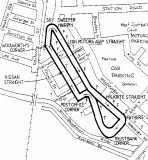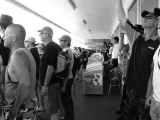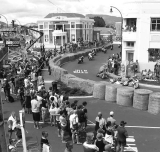Ohinemuri Regional History Journal 54, September 2010
(by Graham Watton, Past President and Life Member, Paeroa Promotions Trust.)
The Battle of the Streets motorcycle race meeting had its beginnings over a "pint of beer" in the Paeroa RSA Club in 1990 when three men Bob Jeffery, Colin Lynch and Sharland Waikato were discussing the world's problems and more importantly the future prospects of Paeroa, which like all rural towns, was feeling the pinch of the changing economy.
Bob, who had in his earlier days raced motorcycles in New Zealand, suggested a street motorcycle race meeting to get the town on the New Zealand events map. Colin had a small motorcycle to get around town, while Sharland, I don't think had any real interest in motorbikes.
The idea was tossed around for a few weeks with others who would listen to the suggestion and soon there was an air of optimism created. Paeroa Promotions Trust was formed and registered as a charitable trust.
Early members of the Trust Executive were Colin Lynch, the first president, Bob Jeffery, Bruce Peacock, Rob Shoosmith, Alex Smith and John Howard. After extensive inquiries among the motorcycle sporting fraternity they found that they did not have the expertise to conduct the meeting and Motorcycle New Zealand was not too receptive to the Trust's approach.
The Trust turned to the Auckland Motorcycle Club, an organisation licensed to conduct such meetings. The Club jumped at the opportunity to become involved because they had made several unsuccessful attempts to establish street racing in their city. On at least three occasions the club got to within a day or so of holding meetings when they had High Court injunctions slapped on them stopping the events going ahead. These experienced enthusiastic club officials were amazed at the support the event received from the community and the Hauraki District Council.
One big problem facing the Trust Executive was getting sufficient volunteers to be able to run the meeting smoothly. An idea emerged to approach several clubs, groups and organisations for support with the promise, "if your members help us we will make a donation to you from the profits". This worked and soon there were sufficient volunteer staff to conduct the meeting.
There were times that the Executive members felt that they had a huge motorcycle by the tail-light and it was moving off at great speed.
As budgets were being prepared it became obvious there were some big costs involved. When the Hauraki District Council declined a request for assistance with funding four members of the Trust Executive offered their homes as security against any loss. This amply demonstrated their confidence of success.
Instead of money, the District Council and Paeroa Ward Committee gave the fullest possible co-operation when it came to sorting out an application under the Resource Management Act consent, street closures, maintenance of the streets in the circuit and the bypass for State Highway 2 traffic. And this assistance has been forthcoming for every meeting since 1992.
The circuit for the first meetings was over 1.52kms around the central business area of the town. Starting in Belmont Road, by the Hall Street intersection, the circuit went east along Belmont Road and Normanby Road, right into Arney Street, over the hill into Princes Street, into the "s" bends linking Princes, Wharf and Marshall Streets, along the back straight to the hairpin opposite the Railway Reserve and back into Belmont Road to the start line.
The circuit has become known as the "hacksaw" owing to its shape.
It has proved a testing circuit on which riders reach speeds of up to 240 kph and sidecars close to 200 kph. along the main straight and was an instant hit with the competitors and officials alike.
After 15 months planning the meeting became a reality with the first event, "Thunder On the Plains" being held on Sunday, February 23, 1992.
This third Sunday in February was chosen after in-depth research of rainfall statistics revealed that this day had the lowest rainfall for the past 20 years, about 0.2 millilitres. The choice proved right because for the 18 meetings held to date the day has always been fine and hot for racing.
One day it started raining from 6 p.m. immediately after the meeting finished and on another day the heavy overnight rain stopped at 6 a.m. and the clouds disappeared.
For several months before the first meeting a team of volunteers with steel cutting and welding equipment turned the used car steel crates, donated by Toyota New Zealand Limited, into safety panels to "fence" the main street section of the circuit.
On race day there are some 340 volunteers involved. Where else would one find a sports event with such a mix of volunteers and the great majority have been involved since the first meeting.
Over the years they come from croquet, athletics, soccer, rugby, touch, darts, air training corps, boy scouts, Legion of Frontiersmen, amateur radio club, BMX Club, women's leisure marchers, Maori culture groups and wardens, local service clubs, Order of St. John, fire brigade, secondary schools sporting and cultural groups, in-line skating hockey, farmers, tradesmen, contractors, transport firms, and local businesses providing staff, machinery, equipment and sponsorship in cash and kind.
On the Saturday before race day much of the circuit equipment is placed in position for an early start next morning on the construction.
Saturday afternoon is also scrutinising for the competitors, from around 2 p.m. to 7 p.m. Officials check all machines for defects, also the rider's protective clothing and most importantly their helmets. It is only for a very special reason the scrutinising office is opened on the day of the event.
Competitors and their support crews stay overnight in all available accommodation in Paeroa and neighbouring towns.
The Paeroa West Rugby and Sports Club open their clubrooms facilities and ground for camping with many staying over the weekend. For the early meeting Club members prepared breakfasts from 5 a.m. and also on Saturday night bar facilities are available.
Others bed-down with their machines in vans, trailers and small tents in the pits area. The Paeroa Little Theatre opens early on Sunday to supply breakfasts and later lunches.
There is a team of over 100 volunteers on Paeroa's central streets from 5 a.m. on race day constructing the circuit. State highway 2 traffic is diverted from the main street along Station Road, Thames Road, Arney Street, Willoughby Street and Victoria Street to rejoin the highway. After an inspection by race officials, the practice session starts around 8.15 a.m. Breakfast is provided for this early group of volunteers, provided by the croquet club members.
The circuit was constructed with approximately one kilometre of steel panels, these have now been replaced with deer-fencing to provide better safety for the spectators, who line the footpaths three and four deep. There is about up to 6kms of netting fencing, some 120 round hay bales, 130 large square bales and 100 small bales, together with 150 wool packs of empty milk bottles. There are some 250 special inserts placed in the footpaths, streets and street verges, which hold steel standards to support the safety fencing.
Several kilometres of aerial wire connects some 30 loud speakers to form an effective public address system covering the circuit. There is also low out-put FM radio in the pits area to enable race officials to make contact with competitors.
During the day there are over 300 volunteers involved as marshals, security, gatekeepers, crossing marshals, crash recovery, emergency services, race officials, communications, plus numerous other personnel to ensure the smooth running of the meeting.
As soon as the last race is completed, around 5 p.m., an army of volunteers dismantle the circuit, and all material goes back to the Trust's store sheds. The hay bales loaded onto the trucks and returned to the farmers' hay barns. The streets are swept, road closure detour signs and other signage removed.
The busy State Highway 2 and Paeroa's central business area returns to normal by around 6.30 p.m.
There are almost 50 hand-held radios issued on race day to officials, nine track marshal points, crash recovery units, track maintenance crews and emergency services to provide an efficient coverage of the circuit. There are also some 300 day food and drink packs issued to all those involved during the day.
Motorcycle racing is a dangerous sport for both competitors and spectators. With something like 600 motorcycle movements during the day and up to 14,000 spectators packed along the footpaths it is essential every step is taken to provide safety and security for all involved. The Trust has spent over $60,000 to completely fence the circuit.
Two fully equipment life support units and a field hospital are brought in by Auckland Order of St. Johns; a rescue helicopter pad is marked out on the Paeroa Domain; there are some 40 Order of St. Johns personnel from Paeroa and neighbouring branches stationed around the circuit to assist both competitors and spectators in times of emergencies.
The Paeroa Fire Brigade, supplemented by outside firemen, are on standby within the circuit. Some 30 personnel from a security firm are employed, while there are some 10 police officers on call.
Not only is the Trust conscious of having adequate emergency services within the circuit, it also ensures that there are sufficient emergency services available to meet the needs of the district, if required..
The first meeting attracted around 180 entries from 130 riders from throughout the North Island and crowd estimated at 8000 spectators. Since then these numbers have gradually built up to a record in 1999 of 273 entries from 220 riders in the programme and crowd of almost 11,000 spectators. In 2007 the crowd was estimated at 14,000, such is the popularity of the meeting.
In recent times the entries have settled at around 200 riders and 270 entries with the crowd being in the vicinity of 12,000 for each meeting.
Free parking is provided on the Domain, supervised by the local athletic club members and the Rotokohu Sports Ground, the home of the Paeroa Rangers Soccer Club. Special security patrolled motorcycle parking areas are provided on the Railway Reserve and along the berm of the Ohinemuri River.
All food for the spectators are provide from the eight permanent food outlets within the circuit area at usual street prices, there are no "outsiders" allowed within this area.
There are four licensed liquor outlets within the circuit, Fathers Tavern, Paeroa Hotel, The Ohinemuri and Paeroa RSA Clubs. Liquor can only be drunk inside these premises. No glass is allowed on the circuit.
A strict control is kept on the sale of merchandise from stalls.
For the 2003 meeting the entry fee was raised from $15 to $20 for adult and free programme and 12-18-year-old $5 to $10. Today it is $25 for adults and $15 for 12-18-year-olds.
After the first event in 1992, Paeroa joined two existing meetings in 1993, Masterton and Wanganui to create the Battle of the Streets series. Masterton dropped out in 1955 to leave Paeroa and Wanganui.
In 1996 the Gisborne Motorcycle Club joined the series. For 1997 Wellington took part with its only meeting, to make the points series over four meetings.
From 1998 the meetings have been Wanganui (Boxing Day), Gisborne (January 2) and Paeroa, the third Sunday in February (except for 2001 when Paeroa was forced to move to March 11).
Gisborne dropped out for 2002, but came back in 2003 in late February and took over the third and final points round from Paeroa. However this was just for one year only. Wanganui and Paeroa continued until 2007 when Wanganui withdrew from the Battle of the Streets competition. This did not deter the "petrol-head" interest in the Paeroa meeting, for in that year an estimated crowd of 14,000 attended.
With the development of the Battle of the Streets series there were seven core classes, Formula one, two, three, 250cc production (dropped in 2001), sports production open (dropped for 2002) and 600cc and side cars.
Paeroa's supporting events have the Classics, over and under 350cc and Post Classics, historic and forgotten era. In earlier years there were BEARS (British, European, American Racing Society), and for one meeting superkarts. The BEARS (British, European, American Racing Society) returned for the 2002 meeting after being absent for several years. In recent years a new class Mopeds have been introduced.
While all the top riders in New Zealand have competed each year there have been a few Australians with three sidecar teams from across the Tasman competing in 1996, six sidecars in 2003 for a great Kiwi-Aussie clash. All competitors have been "wrapped" with the circuit and the organisation.
The community support does not stop with workers on the circuit. Businesses, which provide a seven-day-a-week service, make alternative arrangements, the medical centre changes surgery times.
Two church congregations within the closed circuit area combined their Sunday worship with other churches elsewhere in the town. One of these churches has opened a "drop-in centre" for spectators. The Trust establishes temporary passenger bus and taxi stands for the day.
For residents who live inside the circuit and wish to leave to get away from the noise for the day the Trust provides a security service for their properties. For cats and dogs and other pets, which normal "live" within the circuit area there is accommodation provided for them away from all the noise and any costs met by the Trust.
The event is the largest sporting occasion in the Thames Valley and one of the largest motor sport meetings in New Zealand. It receives excellent support from sponsors, in both cash and kind, to the value of approximately $45,000.
For the first seven years Bel Ray (NZ) Limited, (a high performance lubricating oil company based in the United States of America) had the naming rights.
From 1999 to 2001 Moller Yamaha Limited had the rights with its lubrication product Yamalube. The same sponsor with a change of name to Yamaha Motor New Zealand Limited has generously supported the meeting for the past nine meetings.
After the first meeting some $5,100 was donated back to the 12 clubs, groups and organisations whose members comprised volunteer worker force.
Since then those figures have risen to almost $40.000 from the 2010 meeting and some 30 clubs etc. have been the recipient. After 18 meetings a total of almost $500,000 has gone back into the community.
In the meantime the Trust has established its own insurance fund of $50,000 against a cancellation and has spent over $60,000 on safety fences and other safety measures.
Using the accepted formula to calculate the financial benefit derived from such events, the Battle of the Streets Paeroa is worth approximately $800,000 to the town and district.
In 1997 the Trust restructured with the Executive Committee concentrating on the hard-core business activities such as finance, contracts, authorisations etc., and overall responsibility for the meeting, while the Race Committee is charged with mainly the construction of the circuit and associated activities.
Following the 2001 and 2002 meetings a couple of the top riders drew the organiser's attention to a safety situation in the main straight. The top bikes were reaching 280 kph and then had braking difficulties to take the sharp right hand Fathers corner, especially when they caught up to the tail of the field by the third lap.
For the 2003 meeting the Trust in association with the Clerk of Course Trevor Heaphy, who was the Motorcycling New Zealand Road-Racing Commissioner, and Motorcycling New Zealand stewards re-aligned the circuit with the hairpin being taken out and extra corners added.
This reduced the circuit to 1.35kms in length with the main straight from 670m to around 500m. This took about 50kph off the top speed.
The new layout did not win approval of the top riders on their big machines, but those with small bikes gave the circuit the green light. However, the Trust, which goes through its extensive de-briefing exercise after each meeting, returned to the original circuit for the 2004 meeting.
For each meeting the Trust had to go through Resource Management Act procedures to obtain consent to stage the day and at cost which started at $1000 and had reached $5000 per day. In 2007 the Trust was successful in obtaining a 10-year consent from Hauraki District Council at a cost of $15,000.
An interesting fact is that since the inaugural meeting only two or three members of the Trust Executive and Race Committee personnel have been motorcycle enthusiasts. The remainder have never own a motorbike let alone ridden on one. It is only when the Auckland Motorcycle Club members arrive on race day to conduct the meeting that the "petrol heads" become involve.
This is truly a community effort, one for which it would be hard to find an equal in New Zealand.






